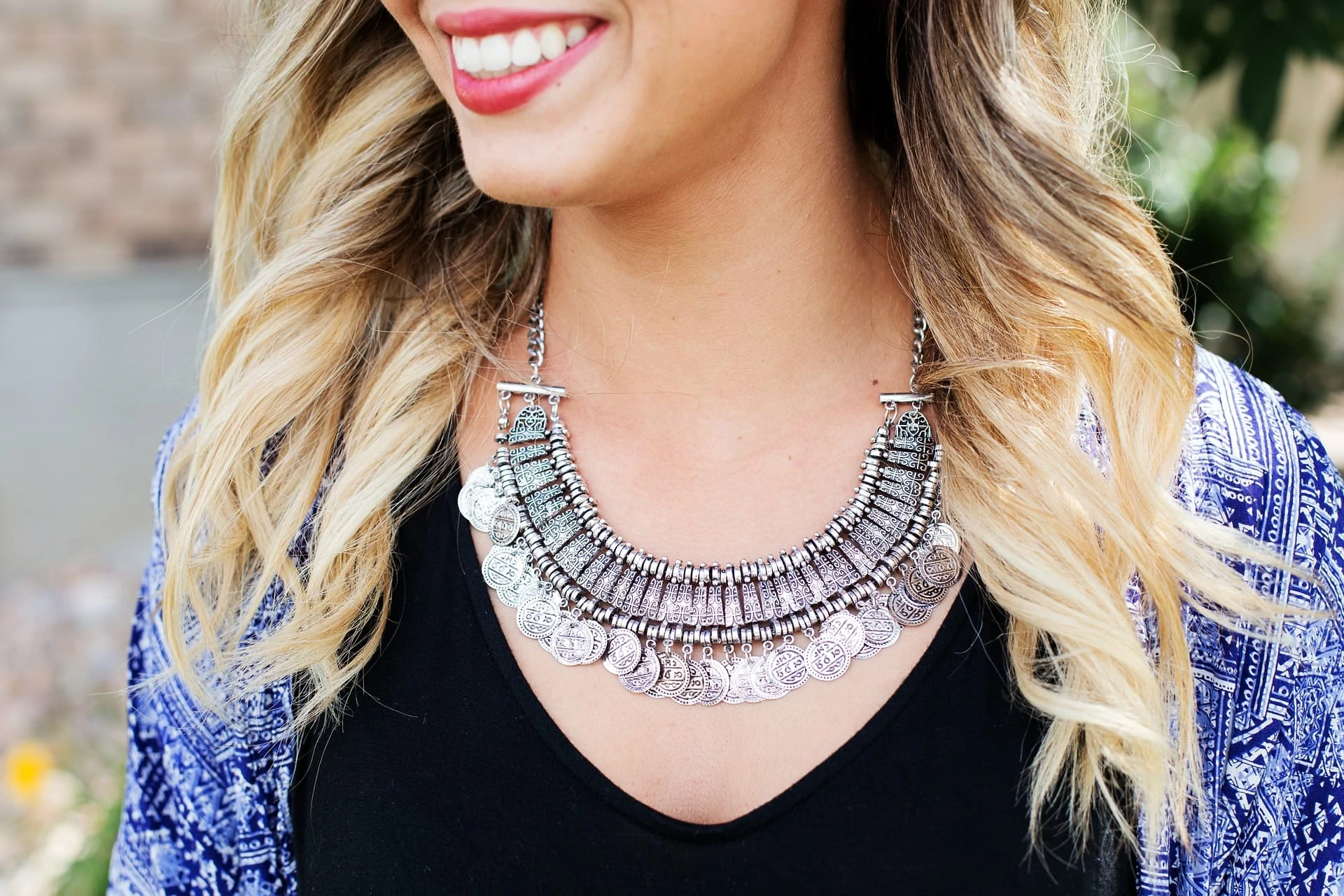
Table of Contents
Necklaces, highly popular in jewelry, come in many styles and designs, appealing to a broad range of tastes with their beauty and variety. Yet, all these different styles share basic components that form the backbone of a necklace.
These consistent elements provide structure and personality to each necklace. Knowing these standard parts helps to understand and appreciate the craftsmanship and detail that go into making these widely loved pieces of jewelry.
So let’s explore parts of a necklace, what role each part carries out, and how to evaluate them when purchasing.
What are the Parts of a Necklace?
To put it simply, a necklace has three main elements. However, these vary, depending on the style of the necklace.
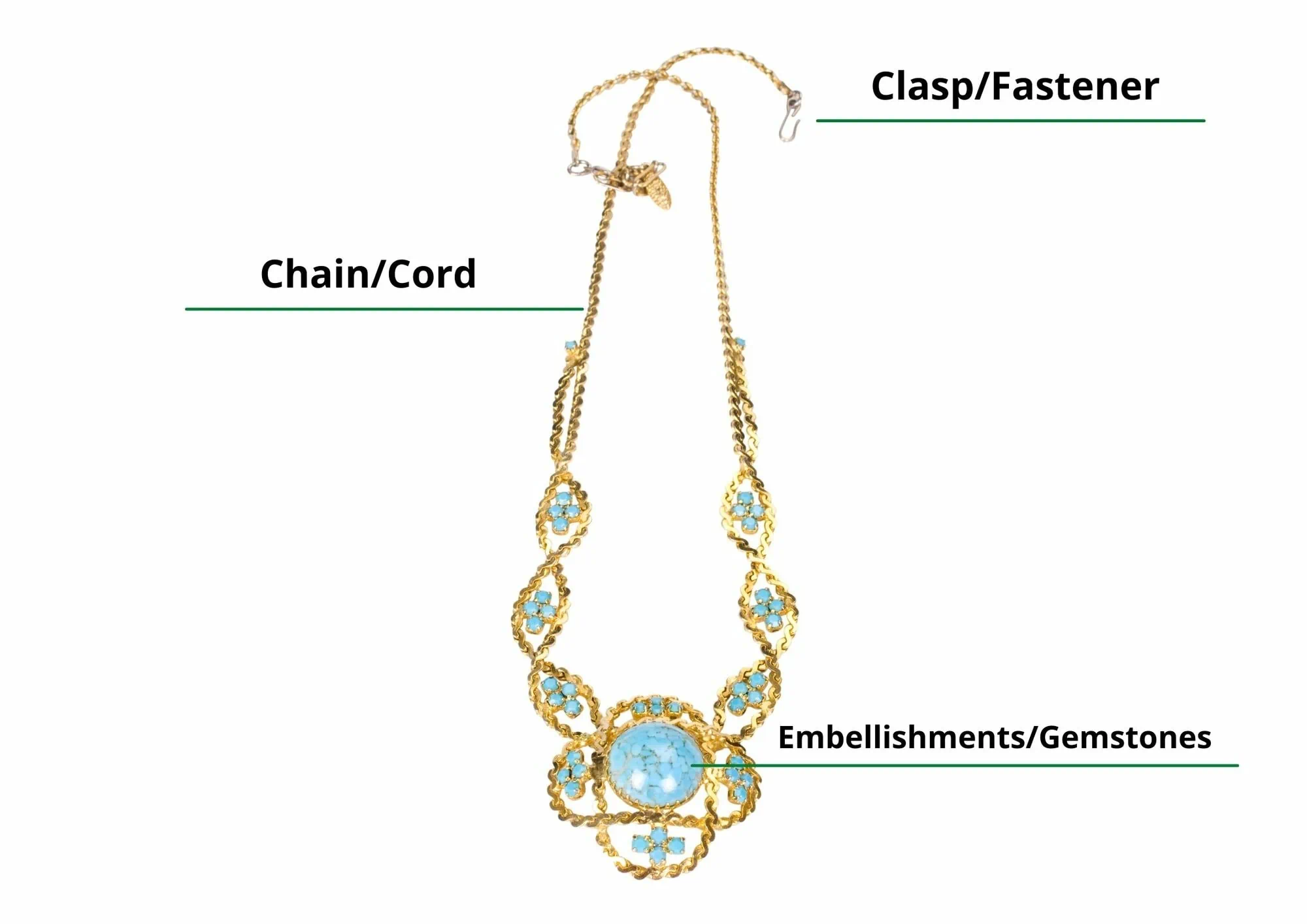
1. Chain or Cord
The chain or cord is the main part of a necklace, wrapping around the neck and forming the base for other elements. Chains, made from metals like gold, silver, or platinum, add a classic and rich look. They vary in length from close-fitting chokers to long chains that hang lower on the chest.
The chain’s style greatly affects the necklace’s look. Common styles include the strong and simple cable chain, the decorative rope chain, and the modern box chain, each with its unique look.
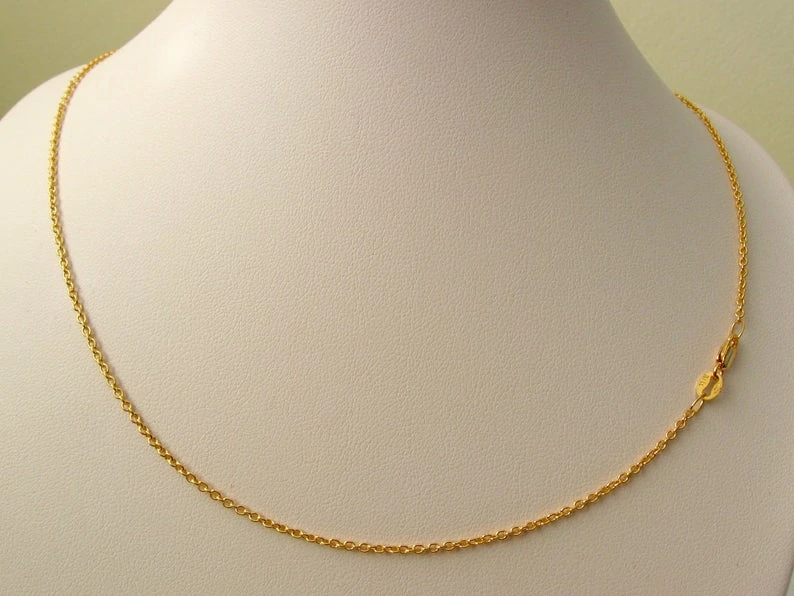
Cords, on the other hand, offer a casual or rustic style. Made from materials like soft leather, strong fabrics, or synthetic options, cords are popular for their comfort and flexibility. They come in various thicknesses, from slim, delicate strings to thicker ropes.
Choosing between a metal chain and a cord mostly depends on personal taste, the style you’re going for, and the occasion you’re dressing for.
Metal chains come in a range of styles. These chains typically have a clasp at the end, which can be taken apart and fastened once the chain is around the neck.
When purchasing a necklace chain, the points to consider include the type of metal, the width and length of the chain and the style of the chain.
What Type of Metal is Used for Chains?
The most common type of metal for chains includes gold and silver. However, there are also several new industrial metals used to make necklace chains, such as titanium or stainless steel.
Precious metals like gold and silver are softer, but they are more valuable and even prestigious. They’re also generally hypoallergenic, and ideal for those who want a bio-compatible option.
On the flip side, the cheaper metals are more durable and affordable. However, some metals, like Titanium, are hypoallergenic also, which is good if you have metal sensitivities.
What about Chain Length and Width?
The length of the chain depends on your purpose of wearing the necklace. The most common lengths for a necklace chain are around 16 to 18 inches, which are the choker and princess lengths respectively.
However, there are other lengths such as the matinee length (20-22 inches), opera length (24-28 inches) and rope length (over 30 inches). Each of these lengths suit different styles of fashion and occasions.
In terms of widths, necklace chains can range from a few millimeters to 15mm and more. Thicker chains are statement making and are often worn without a pendant, while thinner chains work well for daily use.
Different Types of Chains
Finally, when considering types of chains, think about the strength of the chain. Chains with individually soldered links, like cable chains, box chains or curb chains, much more durable than chains with more intricate woven patterns like herringbone chains or snake chains.
There are many types of chains to choose from, and again, the style you choose depends on your fashion choices and how you plan to wear the necklace.
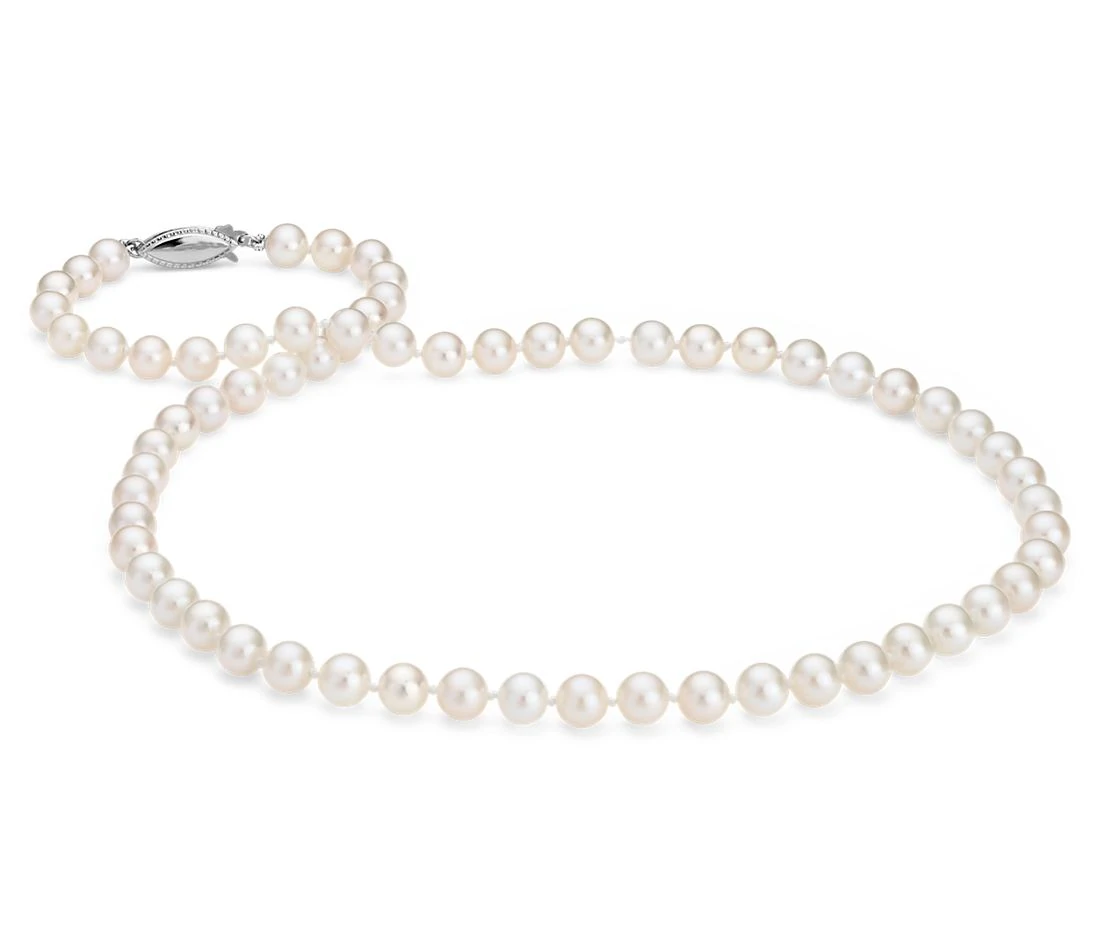
- Cable Chain: A classic choice, the cable chain has identical, round links joined together. It’s simple yet elegant, strong, and versatile for different pendants. Available in various metals like gold, silver, and platinum, and in different thicknesses, the cable chain suits many styles, from subtle to bold.
- Rope Chain: Known for its durability and textured look, the rope chain consists of twisted links forming a spiral pattern. It’s strong, doesn’t tangle easily, and is flexible in style and budget, being available in different metals and thicknesses.
- Box Chain: The box chain has square links forming a smooth chain. It’s strong, making it good for daily use, and its geometric design offers a modern look. Suitable for different pendants and charms, it comes in various thicknesses and metals, fitting both men’s and women’s styles.
- Figaro Chain: Originating in Italy, the Figaro chain is a variation of the cable chain with a pattern of long and short links. It’s versatile, strong, and less prone to tangling. Available in different metals and widths, it’s popular in both casual and formal wear.
- Curb Chain: The curb chain has interlocking, flat links that lie against the skin. It’s durable, versatile, and works for both masculine and feminine styles. Available in various metals, its classic design is suitable for standalone wear or with pendants.
- Snake Chain: The snake chain, with tightly connected rings, forms a flexible, smooth structure. It resembles a snake’s skin, is shiny, and less likely to tangle. Suitable for pendants, it’s available in various lengths and metals.
- Herringbone Chain: The herringbone chain has short, slanted links in rows, creating a herringbone pattern. It lies flat on the skin, is reflective, and eye-catching. However, it’s delicate and can bend easily. Made of precious metals, it’s often worn alone.
- Belcher Chain (Rolo Chain): The Belcher or Rolo chain consists of round or oval links of the same size. It’s simple, strong, and versatile for different pendants. Available in various widths and metals, it’s a classic choice in many jewelry collections.
- Anchor Chain: Inspired by nautical chains, the anchor chain has oval links with a bar across the center. It’s striking, strong, and versatile for casual and formal wear. Available in different metals and sizes, it’s a popular statement piece.
- Bead or Ball Chain: Made of small metal balls linked by wire, the bead or ball chain has a simple, industrial look. Less flexible, it’s often used for dog tags and pendants. Available in different sizes and metals, it’s a versatile, unisex option.
- Wheat Chain: The wheat chain, resembling a wheat stalk, has intertwined tear-shaped links. It’s strong with an intricate texture, making it an attractive standalone chain. Available in various thicknesses and metals, it appeals to those who like detailed jewelry.
- Singapore Chain: The Singapore chain, made of twisted and braided fibers, has a curved, elegant shape. It shines when light hits it, adding sophistication. Fluid and delicate, it’s suitable for standalone wear or with pendants, available in various lengths and metals for different styles.
Necklaces featuring a strand of beads, pearls or gemstones are typically made by stringing these items with a cord or special string. Some typically used cords include:
- Silk – The traditional choice
- Polyester – More modern and stronger
- Leather – Sturdy and stylish, with a masculine appeal
- Plastic-Coated Wires – Like Tiger Tail or hemp, these are very strong and hold heavier beads and gemstones.
Cords vary in thickness and strength depending on the type of bead or gemstone they’re meant to hold. The cord should also fit the drilled holes on the beads which should be able to slide easily onto the cords.
Jewelry with beads and cord tend to fall into the boho or casual styles. However, even fine, classic jewelry can be made with these items.
2. Clasps or Fasteners
Almost all necklaces have some form of clasp or fastener to make them more convenient to wear. However, very long chains often don’t have a clasp as they can simply be worn over the head, without needing to take the chain apart.
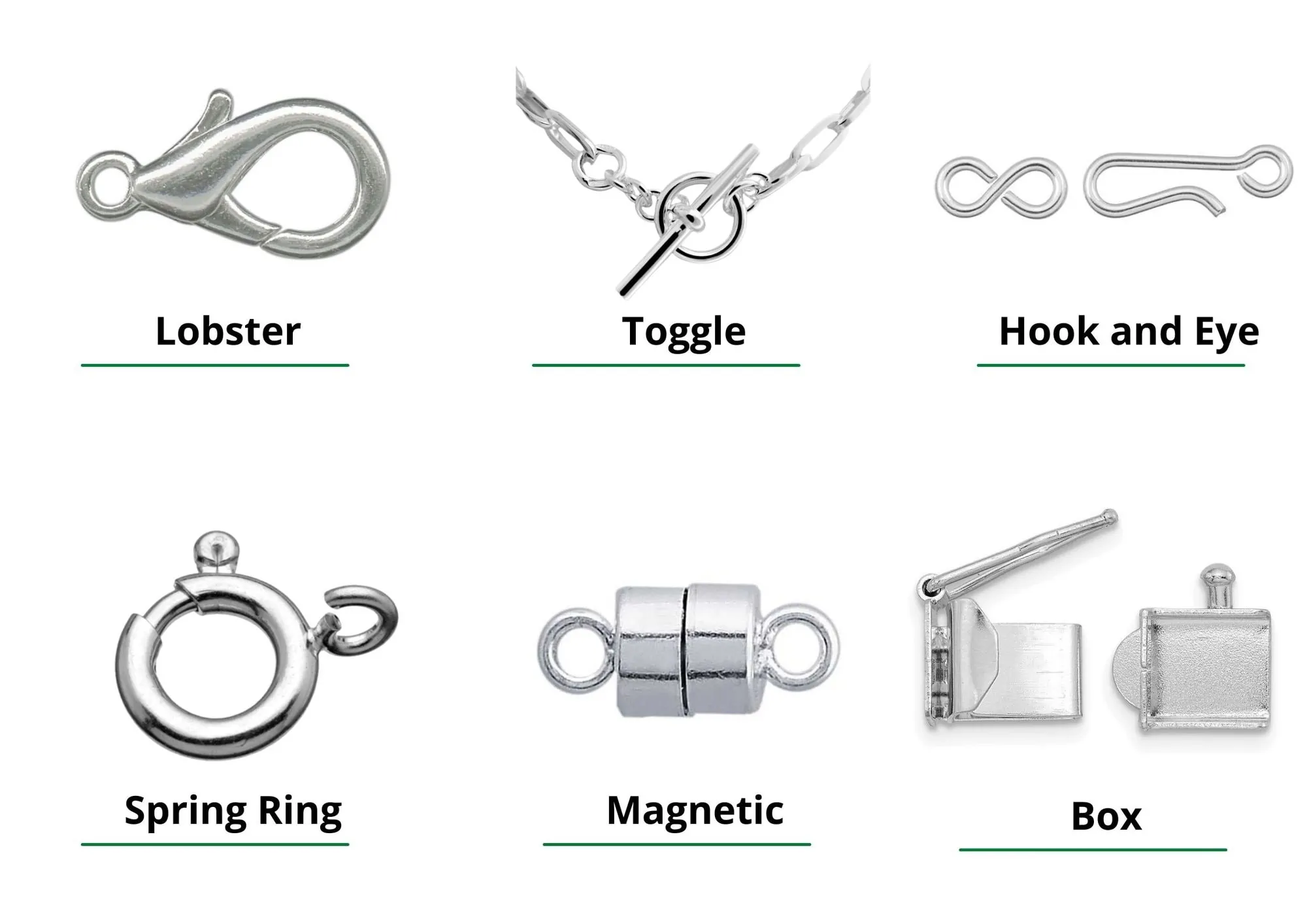
Most people don’t think about the fastener when purchasing, but this is an important part of the necklace. The fastener should be strong and durable enough to carry the weight of the chain.
The most popular types of necklace clasps include:
- Lobster Clasp
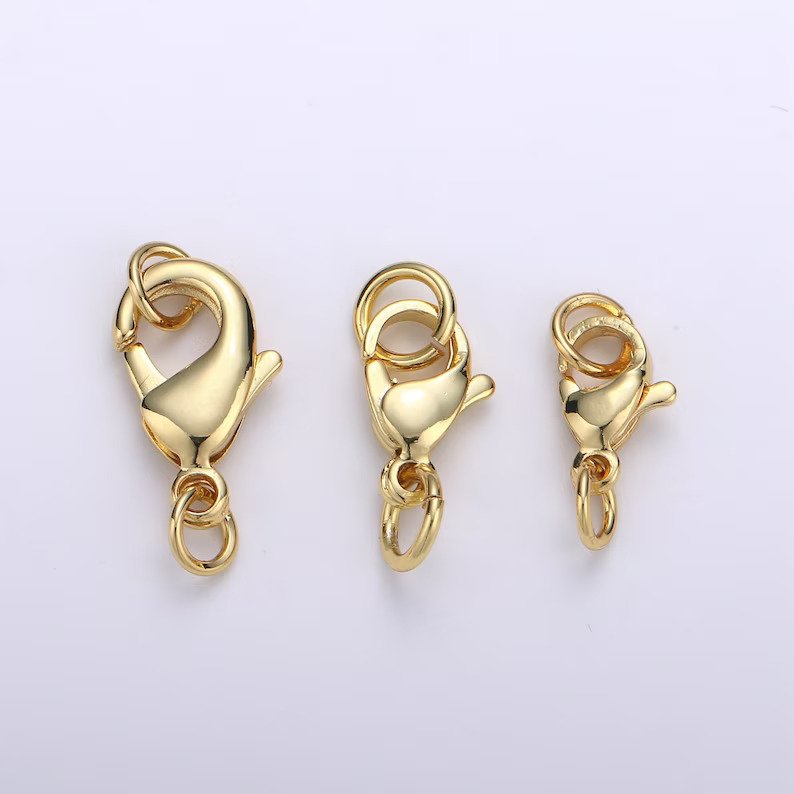
The lobster clasp is widely favored for its secure and user-friendly design, resembling the claw of a lobster. This clasp features a spring-loaded mechanism that is self-closing. To open it, you pull back on a small lever which compresses the spring, and upon release, the clasp automatically shuts.
This type of clasp is highly versatile and can be used in a variety of necklace styles, from delicate chains to heavier pieces. Its reliability and ease of use make it a go-to choice for everyday jewelry, ensuring that your necklace stays securely in place while being easy to put on and take off.
- Spring Ring Clasp
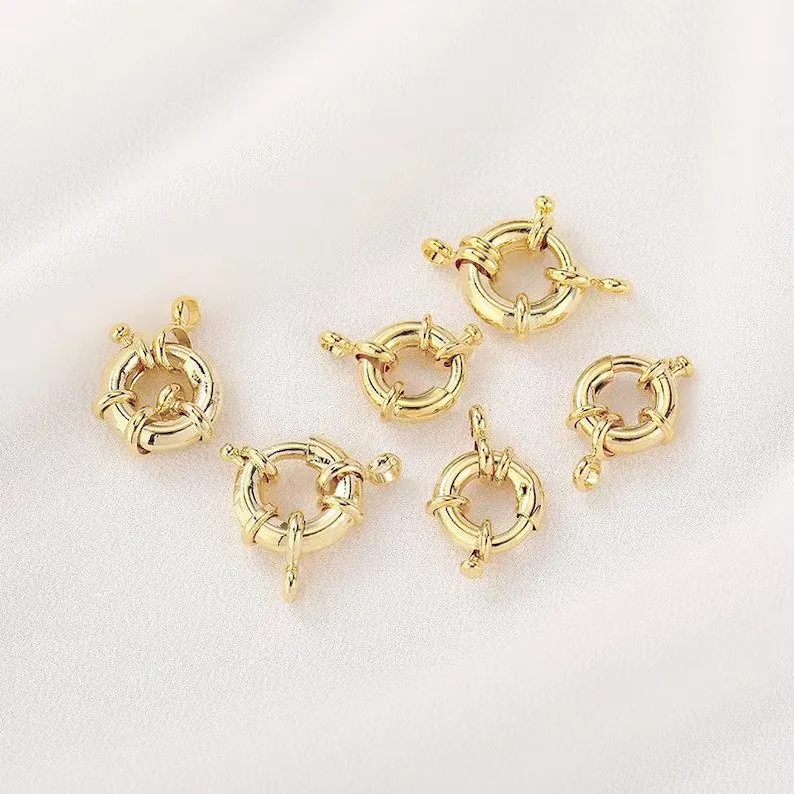
A staple in jewelry design, the spring ring clasp is a simple yet effective closure mechanism. It consists of a hollow, circular tube with a spring mechanism that controls a small lever. When you pull back on the lever, the clasp opens, and releasing it allows the clasp to close.
This mechanism is lightweight and unobtrusive, making it ideal for delicate necklaces. While it offers ease of use, the spring ring clasp requires a bit of dexterity to operate, and its simplicity suits lighter jewelry pieces rather than heavy or expensive items.
- Toggle Clasp
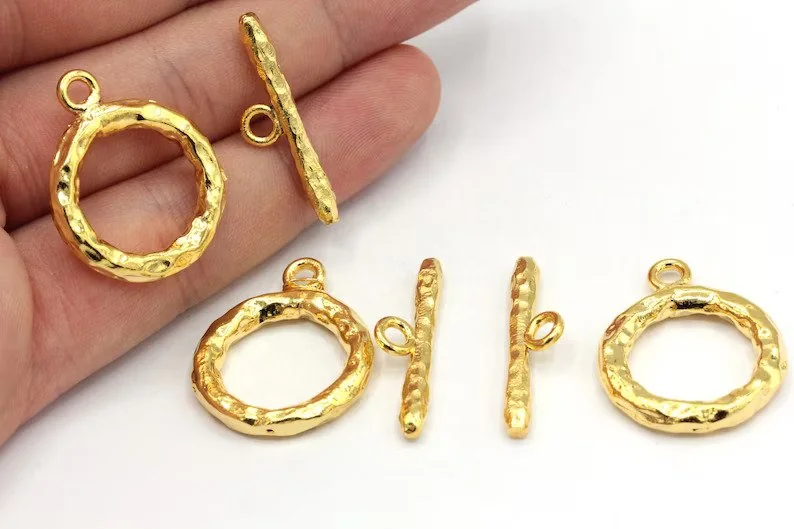
The toggle clasp is both functional and decorative, adding a stylish element to necklace designs. It comprises two distinct parts: a ring on one end and a T-shaped bar on the other. To fasten the clasp, you simply slide the bar through the ring, where it sits securely due to its length.
Toggle clasps come in various sizes and designs, from simple and sleek to ornate and decorative. This clasp is easy to use and adds a unique aesthetic to the necklace, but it’s less secure compared to other types, making it more suitable for lighter necklaces.
- Magnetic Clasp
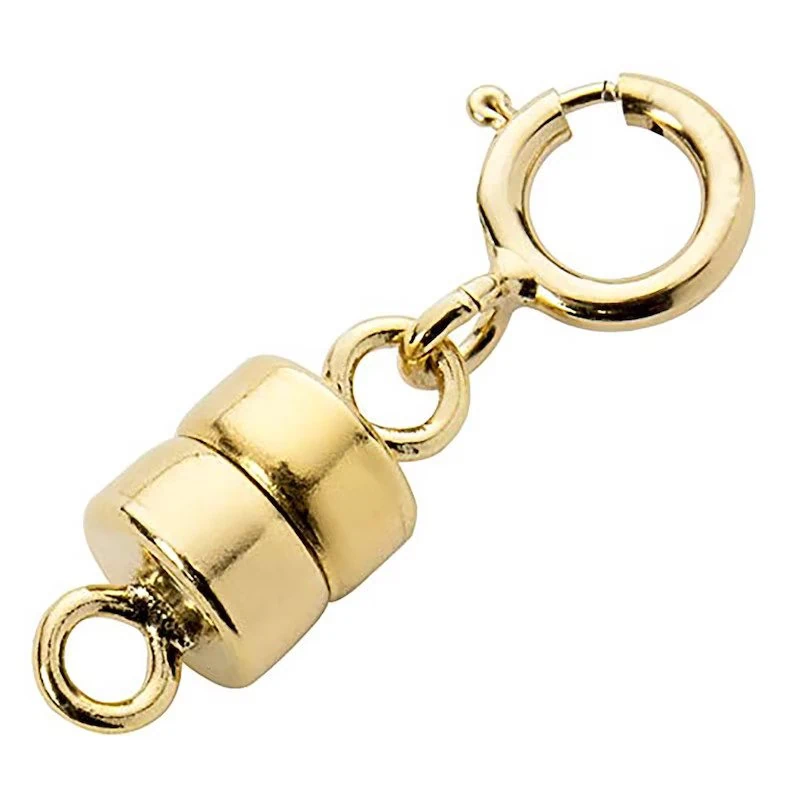
Magnetic clasps offer simplicity and ease, especially beneficial for those with limited dexterity. These clasps use strong magnets to hold the ends of the necklace together. To wear or remove the necklace, you simply pull the magnets apart or bring them close together.
While incredibly user-friendly, magnetic clasps are not as secure as other types and might come undone with enough force. They are a popular choice for lightweight necklaces and bracelets, offering convenience for quick wear.
- S Hook Clasp
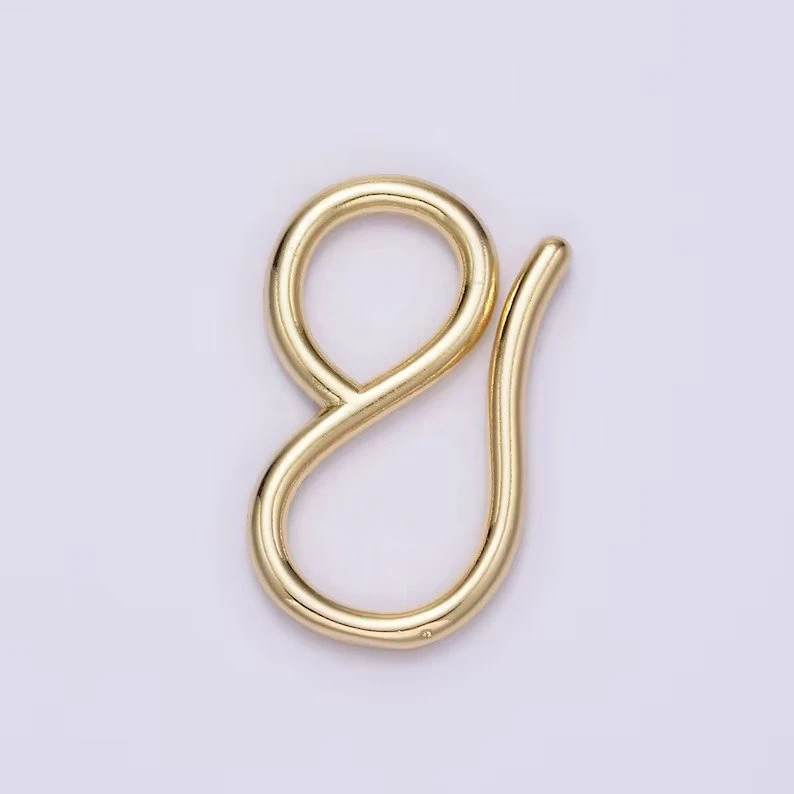
An S Hook clasp is straightforward in its design, shaped like the letter ‘S’. One end hooks into a ring or loop on one side of the necklace, and the other end hooks into a ring on the opposite side. This clasp is easy to use and often adds a decorative touch to the jewelry.
However, it’s not as secure as some other clasp types, as it can unhook if caught on clothing or other objects. The S Hook clasp is a good choice for casual necklaces where security is not the primary concern.
- Fishhook Clasp
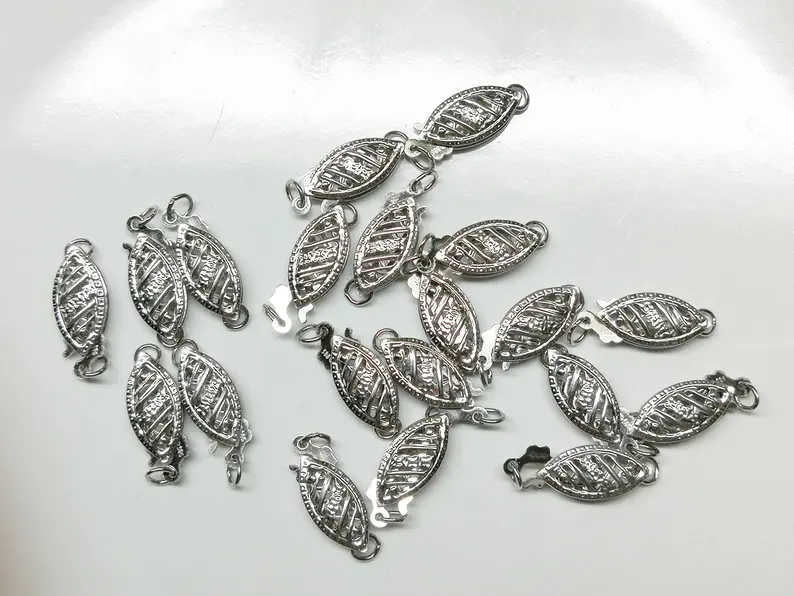
The fishhook clasp is a traditional and secure closure for necklaces. It consists of a metal hook and an oval-shaped box. To fasten the necklace, you slide the hook into the box, where it locks in place.
This clasp is often used in fine jewelry thanks to its elegant appearance and reliable security. It provides a more seamless look than some other clasps, but can be a bit tricky to fasten without assistance.
- Box Clasp
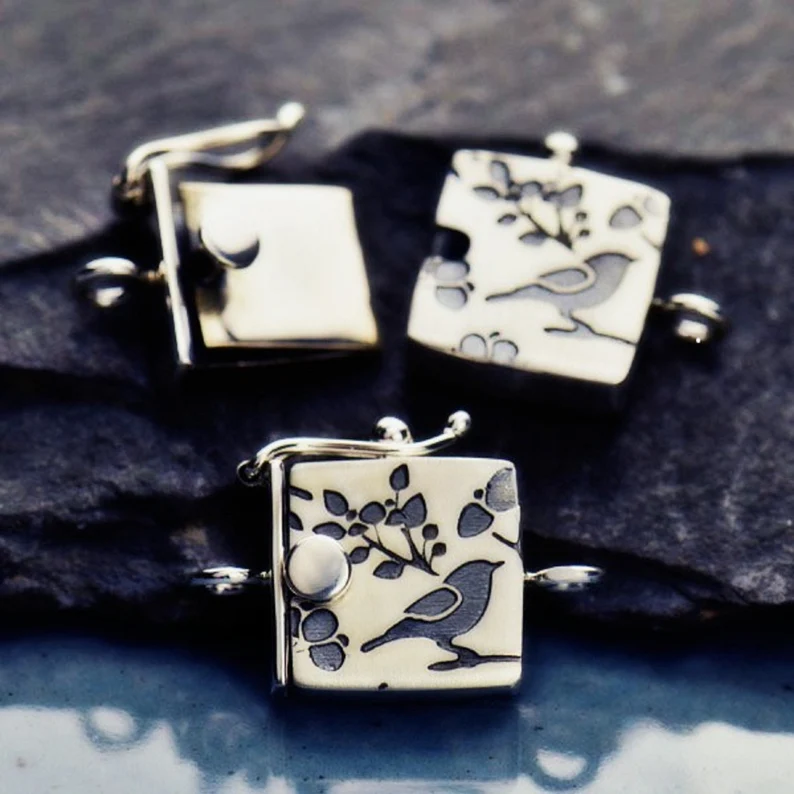
The box clasp is both secure and decorative, often found in higher-end jewelry. It features a small, spring-loaded tongue that, when pressed, releases from a box-shaped enclosure. Upon releasing the tongue, it snaps back into the locked position inside the box.
Box clasps are often embellished with gemstones or intricate designs, adding a decorative element to the necklace. While secure, they require a bit of effort to open and close, and their decorative nature makes them a popular choice for formal and fine jewelry.
- Slide Lock Clasp
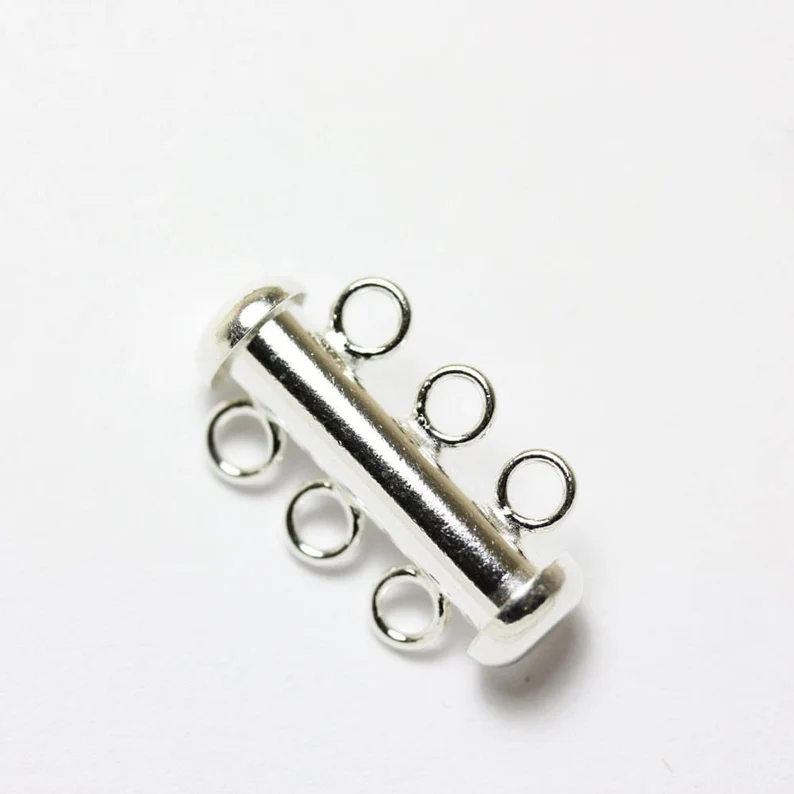
Ideal for multi-strand necklaces, the slide lock clasp offers excellent security and support. It consists of two tubes, one sliding inside the other and locking in place. This design ensures that the clasp can bear the weight of heavier necklaces or those with multiple strands without coming undone.
The slide lock clasp is typically longer than other clasps, providing a balanced and secure closure that keeps all strands aligned.
- Barrel Clasp
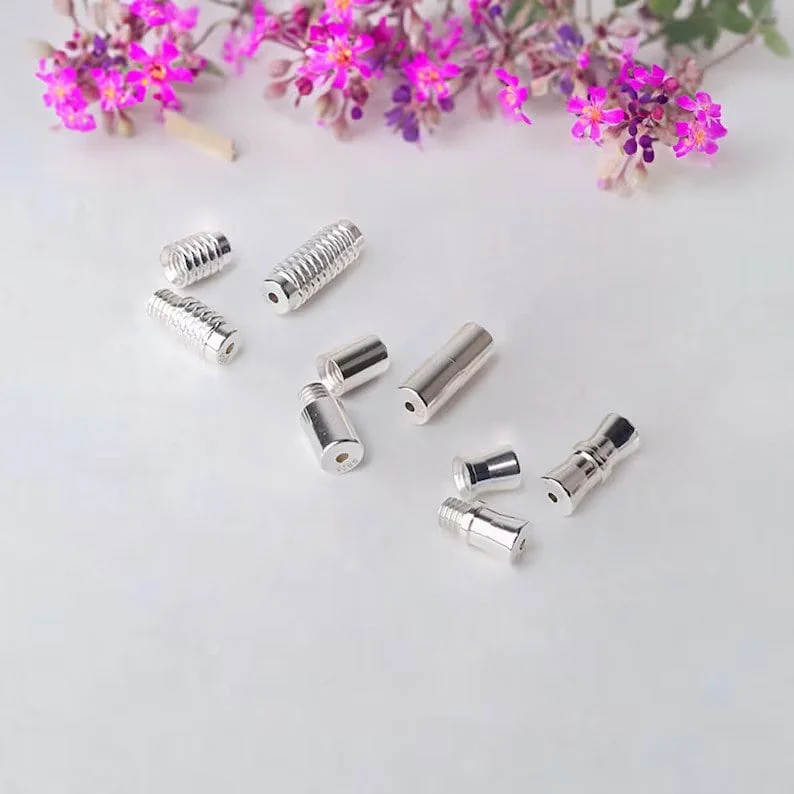
The barrel clasp, shaped like a barrel, is made up of two metal pieces that screw together. This design offers a high level of security, as it won’t easily come undone. However, screwing and unscrewing the clasp can be challenging, particularly for those with limited hand mobility.
The barrel clasp is discreet and doesn’t detract from the necklace’s design, making it a good choice for designs where the focus is on the necklace itself rather than the clasp.
- Bead/Ball Clasp
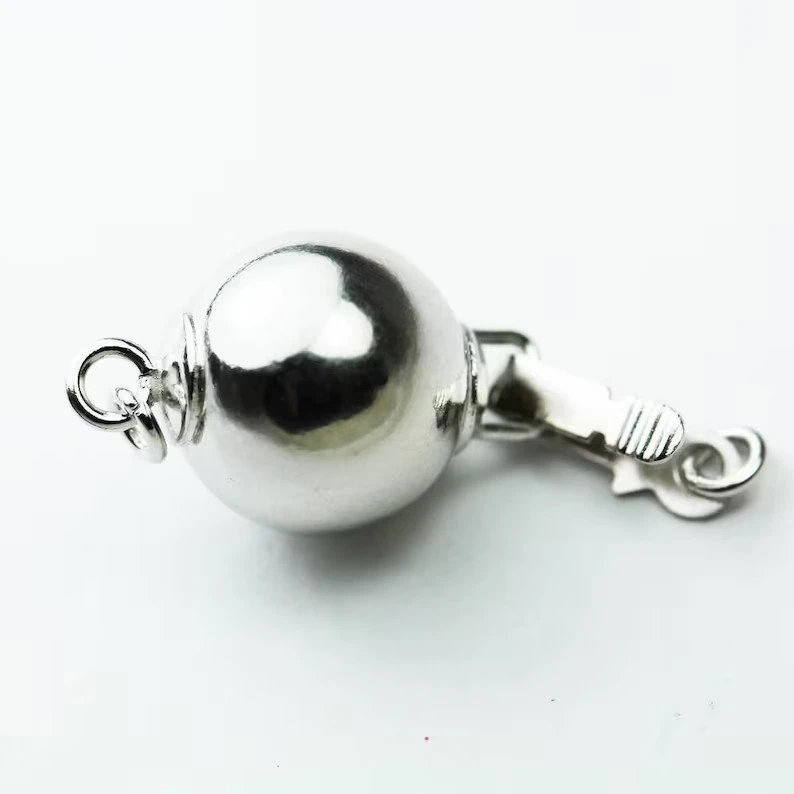
Similar in function to the barrel clasp, the bead or ball clasp screws together and is often used in pearl necklaces for its aesthetic appeal. It typically features a beaded design that blends seamlessly with the necklace, especially with pearl or bead necklaces.
The bead clasp provides a secure closure and adds a touch of elegance to the piece, making it a popular choice for classic and formal jewelry designs.
3. Embellishments
And finally, what makes a necklace unique and stand out from others is the embellishments that are added to it. These are typically pendants, but they can also be attached to the chain or cord, like this stationed necklace.
- Pendants:
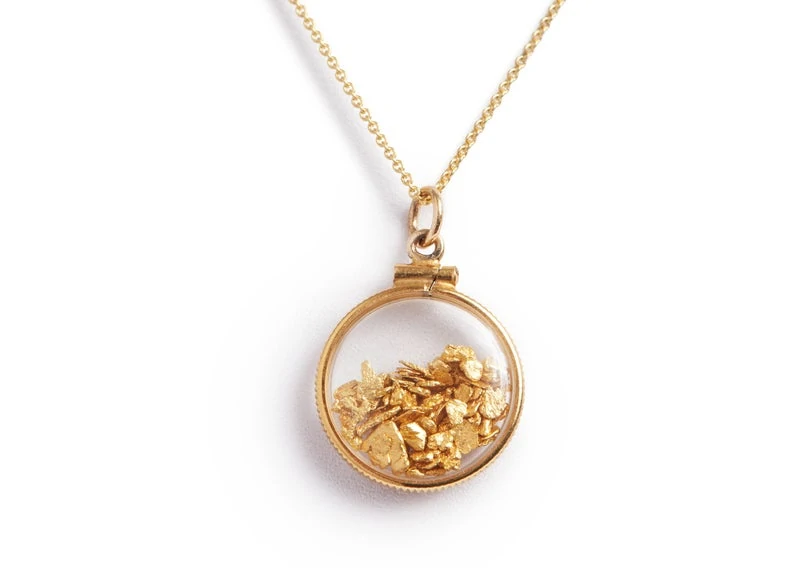
Pendants are often mistaken to be the same as necklaces, but these are two different things. A pendant is the ornament that’s attached to and hangs from the necklace chain or cord. It’s not the necklace itself.
Pendants vary in design, size and style. Pendants feature gemstones, symbols, filigree metalwork and more. They’re typically made of metal, but there are pendants made of feathers and paper too. It all depends on the designer’s style. Pendants are an excellent way to showcase your personality and style, because there are endless types of pendants.
Smaller types of pendants are called charms and are typically worn on bracelets. If you’re into minimalist designs, a charm pendant might work better for you on a small, chain necklace, rather than a large pendant.
When buying your pendant, consider the size of the bail and whether it fits the chain you’ve chosen.
- Lockets:
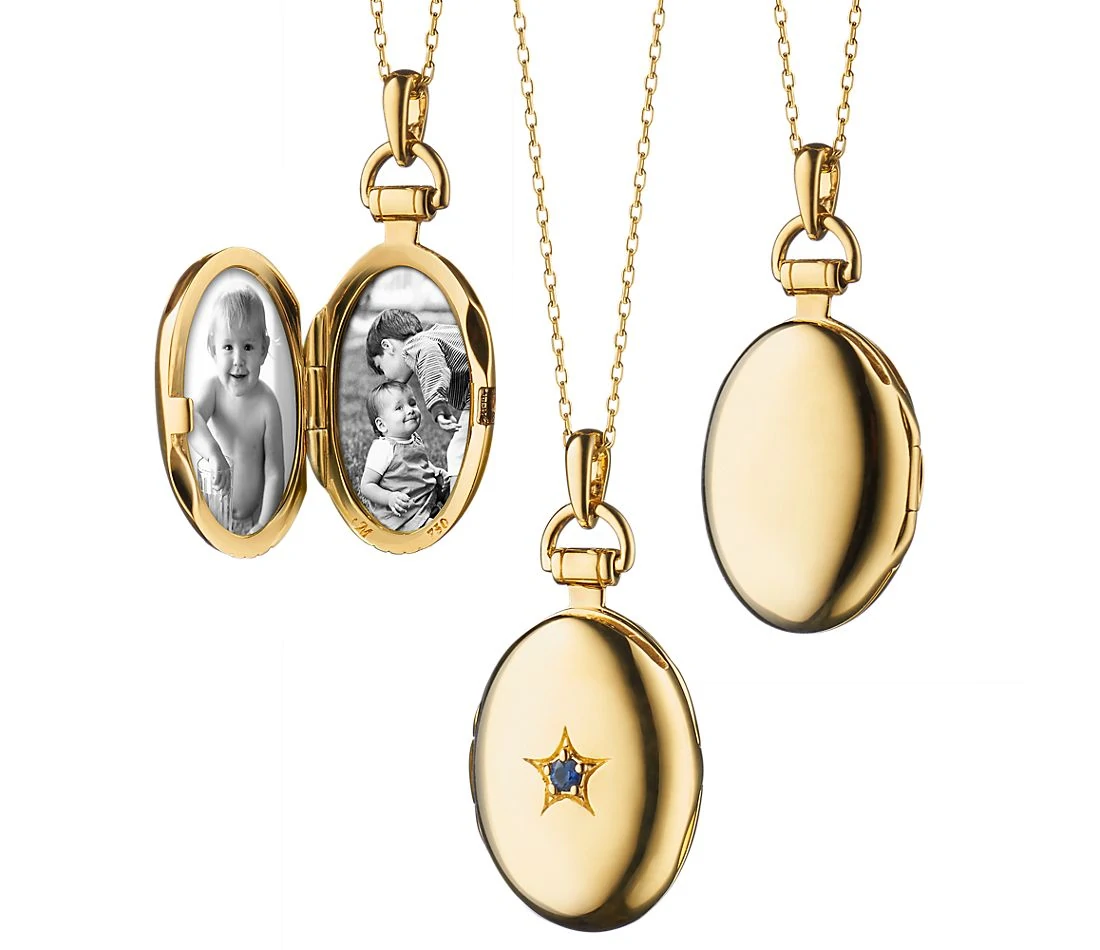
Lockets are a type of pendant, but the main difference is that they feature a hinged door that can be opened and closed. Inside is a little compartment that can hold photos, sentimental tokens, or engravings.
- Metalwork:
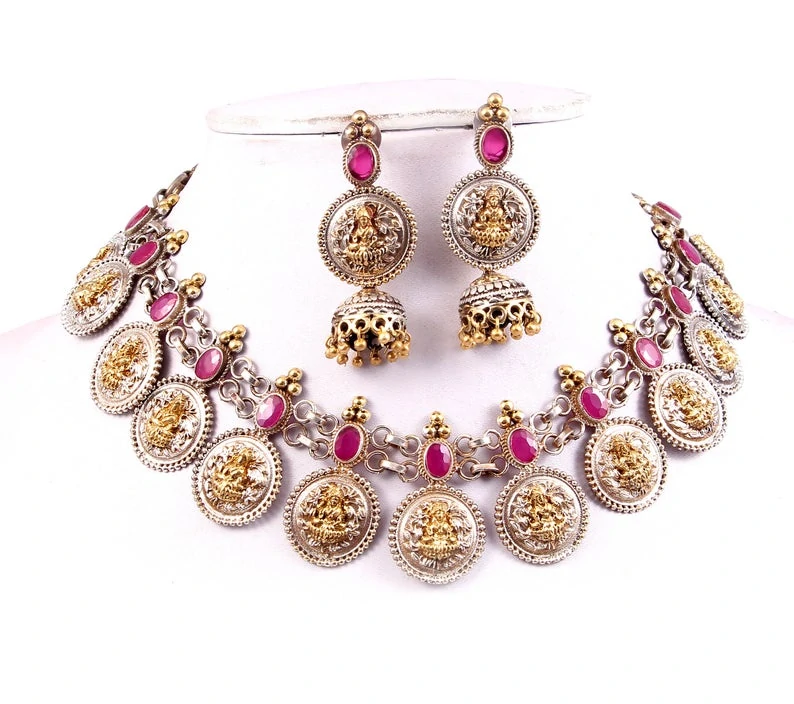
Some necklaces, like the Indian necklace featured above, are heavily embellished with intricate metalwork, filigree and gemstones. On closer inspection, this necklace is a rolo style chain, with attached gemstone and metal pendants at regular intervals.
- Festoons:
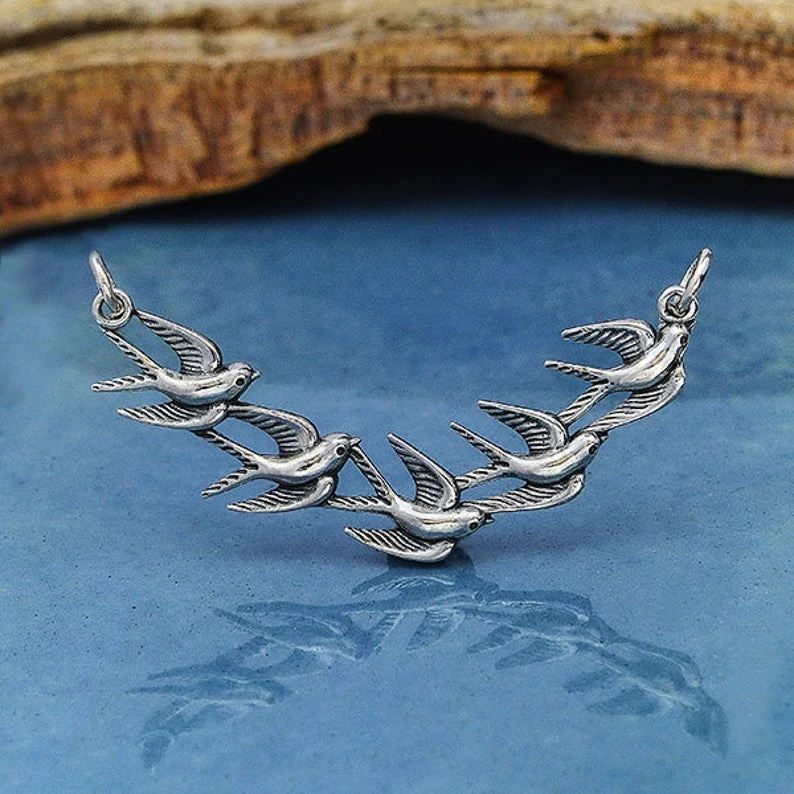
Another type of pendant, festoons are larger and wider designs that can be attached to a chain. They’re more decorative and are often worn for more formal occasions or when you want to make a statement with your style.
Wrapping Up
While necklaces vary in design, the above discussion demonstrates that almost all necklaces have these three parts – chain/cord, fastener and embellishment. Evaluating each of these three aspects will help you choose a quality necklace that suits your lifestyle.









